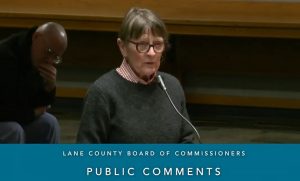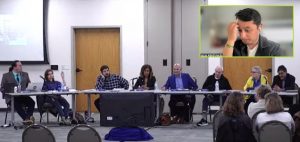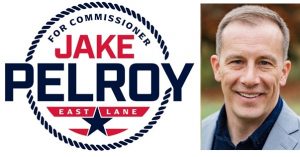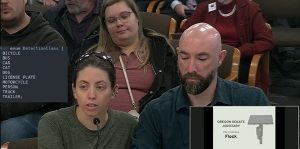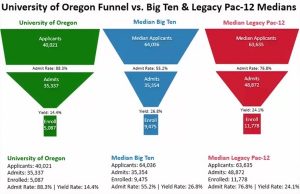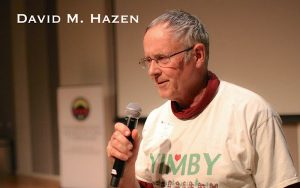Neighborhoods sign on to support public health overlay zone
6 min read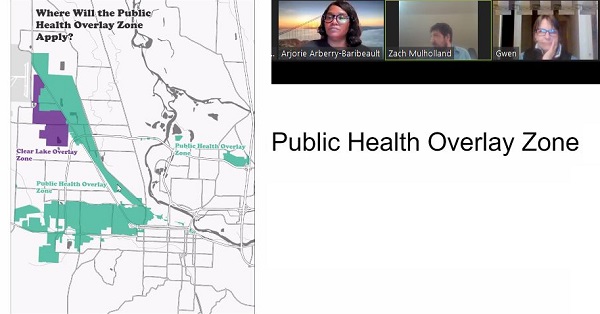
Neighborhoods voice support for a public health overlay zone. At Jefferson Westside on Jan. 10, a presentation from Beyond Toxics.
Arjorie Arberry-Baribeault (Beyond Toxics): My name is Arjorie Arberry-Baribeault and I am the West Eugene community organizer for Beyond Toxics.
[00:00:06] So what is a public health overlay zone? Why do we need it in place? Well, 95% of all of the air toxins in Eugene is in the 97402 zip code area. This is a list from Cleaner Air Oregon, and we have all these worst polluters, 95% of those polluters are in the West Eugene area, 97402, where there’s higher cancer rates, higher asthma rates, and a lower life expectancy.
[00:00:37] The vast majority of the folks that live in West Eugene are low-income. You know, they’re working-class folks. They live in West Eugene because it’s affordable. You know, they can buy a house there. A lot of times it’s hard to buy a home and they’re affordable out in West Eugene and that’s a good thing, so that people can buy their homes.
[00:00:56] But, you know, you can be sort of unaware of what’s going on, what you’re surrounded by. We were a family that was impacted negatively by living in West Eugene. And a lot of the people that I have talked to have had their families’ health impacted, or had their own health negatively impacted, by living out in West Eugene.
[00:01:18] You know, Beyond Toxics has worked out in West Eugene for a long time, so because of the work of Beyond Toxics and the West Eugene community, the OHA (Oregon Health Authority) did a cancer study and they found that there were higher rates of lung cancer and Hodgkin’s lymphoma in the industrial area right there on Roosevelt Avenue.
[00:01:41] My daughter, who’s a cancer survivor now—I want to put that out there before I go any further with this— went through hell and back, and ended up having a stem cell transplant and the whole gamut, she was diagnosed with Hodgkin’s lymphoma when she was 13. And so I was curious like, what, what could be going on? How could she be sick like this?
[00:02:03] So I started to dig around and, and found about J.H. Baxter, looked into West Eugene. I lived in West Eugene for 30 years and during that time it was always surrounded by industry. And when you’re living in that industry, when you’re living in that neighborhood, it just becomes normal. (Mm-hmm.) It just becomes normal to see a smokestack or it just becomes normal to smell something or see these giant facilities. You’re not really thinking about what it could be doing to your health.
[00:02:33] Rene Kane: You know, the other day I walked out on my porch and it was stanky. It was awful. And it was chemical-ly, or, you know, when Rexius used to be out on Bailey Hill, it was like: ‘Ohhh, cover your compost.’
[00:02:51] But I think that it might be: The air doesn’t know our neighborhood boundaries, is what I want to say. And we’re breathing that. We’re probably not breathing that as much as the folks who live right there, but we’re all breathing that, and I think it’s in our best interest to support the overlay zone for ourselves and for our neighbors, and for our neighbors’ health.
[00:03:18] But I just— it’s an artificial barrier to say this affects West Eugene. This affects all of Eugene. So yeah, I’m in favor.
[00:03:27] John Q : At Jefferson Westside in January:
[00:03:32] Arjorie Arberry-Baribeault (Beyond Toxics): I appreciate you saying that for sure. Because the air doesn’t know , the air doesn’t stop and it does go all over, which is why council has been saying, and we’re for it too. We want it to be citywide. We want it. We want it to be nationwide. Mm. This isn’t just a Eugene problem, this is a world problem and this is revolutionary.
[00:03:54] To have something like this be put in place can save so many lives, not just in Eugene, just just around the world. Being in environmental justice, I read about these places that are West Eugene. You know, there’s so many places around the world that are like this and there’s so many places that are built right up against industry and some people are oblivious to that, but that doesn’t mean they don’t have the right, just because they don’t know what’s going on.
[00:04:24] So this, I appreciate you saying that. Yes, the wind doesn’t differentiate where it’s supposed to be, and that this is definitely something that could be citywide.
[00:04:35] Zach Mulholland: Thank you for your thoughts. I will just add that if you do smell something bad that you think is a polluter near you, please do report it to be LRAPA.
[00:04:45] So with that background on sort of the why we need a public health overlay zone given the lower life expectancy and health risks in West Eugene, the Clear Lake Overlay Zone is a model that we can potentially adopt elsewhere in the city that bans these worst land uses and requires manufacturing be done indoors when it’s closest to homes in schools and parks.
[00:05:05] John Q: Why the Clear Lake Overlay Zone?
[00:05:07] Arjorie Arberry-Baribeault: When the city expanded its urban growth boundary with the Clear Lake Urban Growth Boundary to bring in industrial and manufacturing jobs, the schools, parkland, it implemented—the city implemented the Clear Lake overlay. And the Clear Lake overlay zone was implemented in this area to strengthen the land use laws to limit the potential impacts of nearby residents.
[00:05:32] They were able to do this because—the city was able to do this because that land was undeveloped. There was nothing out there. So the Clear Lake Overlay Zone regulations identify things that are restricted or prohibited within that overlay zone to help avoid the co-mingling of odorous emissions or particulate downfalls, we want to prevent that co-mingling with the nearby residents and schools and parks.
[00:05:59] So that’s why the Clear Lake Overlay Zone was implemented, to protect the health. The regulations identified and restricted some things that were banned, some of those things that we want to implement in our own overlay zone, which is a public health overlay zone.
[00:06:15] So this is something that’s already in place. This is a model that’s already, it’s already happening right now in West Eugene, so what we’re wanting to do is sort of combine it a little bit with our own and make it stronger to protect those lives that are living out there in that area.
[00:06:37] And Zach will talk a little bit more about that.
[00:06:39] Zach Mulholland: So in addition to making these rules for when we have industry zoned next to residential areas, there’s also potentially an opportunity to rezone some of those areas where we can see those conflicts are going to occur.
[00:06:54] So for example there’s a big apartment constructed at 18th and Willow Creek last year, right across the street from some industrial areas near the old Hynix plant. And there’s a number of additional residential areas, former agricultural land, that are also slated for residential development in those areas directly adjacent to industry. And so we want the city to take a look at potentially rezoning these and similar sites to try and get out ahead of that those conflicts and create some buffers between them.
[00:07:24] And if and when the city expands its urban growth boundary, out towards Fern Ridge, we want rules in place so that the city never locates residential zones right next to industrial zones in the future and just have those rules in place to prevent that so that we don’t end up with a similar situation of residential areas right next to industrial zones during those future expansions.
[00:07:46] There’s a big push to expand the rail line out to the coast and to put in a big deepwater port in Coos Bay where they would potentially be bringing in shipping containers and loading them onto rail and bringing them into Eugene and loading them onto trucks.
[00:08:02] And there’s a big desire that when the city goes west towards Fern Ridge during its next expansion process, which that’s the direction they’re looking at for potential future expansions, that again, that we don’t make the same mistake of having residential areas right next to train tracks.
[00:08:16] Arjorie Arberry-Baribeault: The community’s ready for positive changes. Their eyes are open to what’s surrounding them now.
[00:08:22] John Q: Neighborhoods sign in support of an overlay zone to protect public health.
